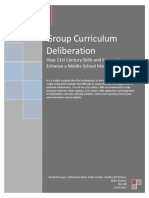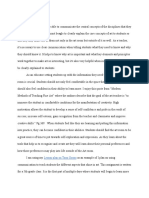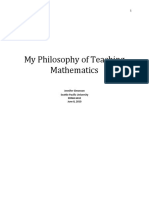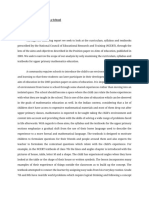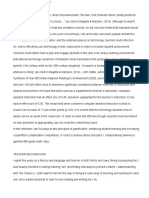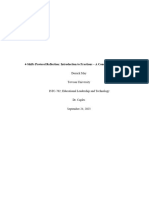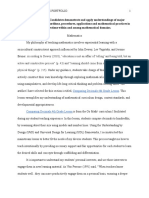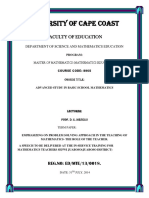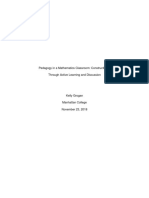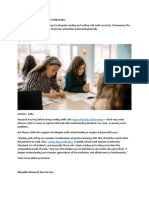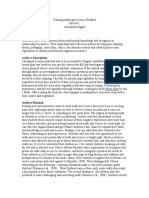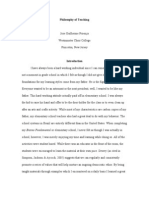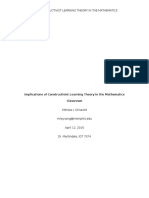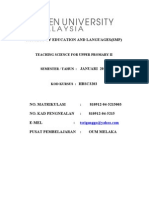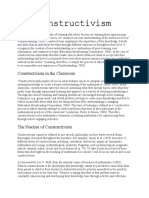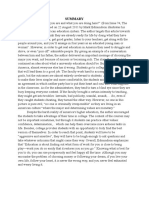Rationale
Rationale
Uploaded by
api-253723917Copyright:
Available Formats
Rationale
Rationale
Uploaded by
api-253723917Original Title
Copyright
Available Formats
Share this document
Did you find this document useful?
Is this content inappropriate?
Copyright:
Available Formats
Rationale
Rationale
Uploaded by
api-253723917Copyright:
Available Formats
!
"#$%&"'(
Introduction
Compartmentalization of disciplines in todays high schools is ubiquitous. Anecdotally,
we see this daily in our classes. Students spend forty to sixty minutes learning about math. The
bell rings and then those students turn off Math and travel to another room where Social
Studies is learned. Repeat that process eight or nine times a day and you have a portrait of the
learning schedule of the American teenager. Students are generally not taught that their school
subjects are related. Curricular models that are implemented in this age of heightened pressure
of high-stakes testing tend to be hyper focused on deep understanding of isolated disciplines. It
is our belief that deep understanding of educational content can be enhanced by the marriage of
disciplines in an authentic and meaningful way.
The Art of Mathematics presents an interdisciplinary curriculum framework that melds art
and math in an effort to illustrate that any content teacher need not be intimidated by
incorporating subjects that are unfamiliar to them into their curriculum. This unit can serve as a
readymade, stand-alone unit taught in an art or math class. However, it was designed with the
plan of being a single unit in a semester long interdisciplinary mathematics elective course for
students who have studied Algebra and Geometry. It would also be adaptable to the college
level to fulfill core course requirements for both math and art majors. For instance, The Art of
Mathematics, would be a fitting math general education requirement for an Art Major, and vice
versa.
We are designing this curriculum because there is a lack of interdisciplinary curricula
currently being implemented in high schools. Teachers are often overwhelmed or nervous about
trying an interdisciplinary curriculum and administrators are often unwilling to let teachers try
new things that may, in their eyes, jeopardize test scores. It is important for school leaders to
recognize the value of designing curriculum around big ideas. As administrators worry about
how to bring up test scores, many are increasingly directing teachers to deliver to students long
lists of isolated bits of information and skills [that do not] engage students intellectually
(Sleeter, 2005, p. 62). Teachers faced with potentially unsupportive administrators may be less
likely to experiment with multiple disciplines, or anything out of the norm of traditional
curriculum.
This is really a shame because there is much to be learned from viewing things from
different perspectives. Like so much of mathematics, theres a beautiful side to it that I fear
does not get enough attention in our schools. We spend lots of time talking about calculation,
but lets not forget about application including perhaps the most important application of all:
learning how to think (Benjamin, 2013). It is our hope that by presenting mathematics in an
arts-based way to high school students they will be inspired to further pursue knowledge of
mathematics and art. Furthermore, the student of integrated math and art in curricula shows
potential for congruent activities that will enhance learning in both disciplines (p. 17, Bickley-
Greene).
The four-week unit presented here focuses on The Golden Ratio. Discussed in the unit
will be the mathematical definition of the golden ratio, its applications in geometry, nature and
visual arts, and the implications for the perception art.
Role of the Student
This course is designed to be appealing to a variety of students, since it is a true blend of
mathematics and art. Students who may not be interested in math or who may have math-
phobia would benefit from a curriculum that engages them in doing something that they find
interesting or exciting. Students who may not consider themselves good artists but enjoy math
will find that mathematics and technology makes it easy to create art they would otherwise not
be able to make.
Students are expected to be active learners throughout this course. They will have the
opportunity to put into practice what they learn by creating their own works of art. Students will
be required to create artworks using technology and through traditional art mediums, such as
drawing and photography.
Additionally, students will be expected to engage in thoughtful dialogue through a series
of small group and whole class discussions, as well as art critiques. These conversations will
take place in the classroom and in a museum. The rewards of dialogue can involve ownership
of concrete understanding, the opportunity to reflect in new ways about a life issue, which may
also relate to the school curriculum (Hubard, 2010, p. 44).
Role of the Teacher
The design of this curriculum is meant to be completely user-friendly for the educator,
regardless of their area of expertise. The teacher is expected to serve as a facilitator and mentor
for the students. Direct instruction will be followed by hands on activity during which the
teacher will be able to observe the students and help them clear up any misunderstandings as
well as develop their creativity.
In the act of talking about art, it will be the role of the teacher to guide meaningful and
informative dialogues about the nature of art and geometry. Perhaps in classrooms the language
that we use to teach art and geometry might become more inclusive to show how various
geometries are and how experiential the activity of geometry is (Bickley-Green, 1995, p.11).
Teachers will be encouraged to develop discussion questions to facilitate classroom
conversations and then take a step back. Teachers should offer encouragement, but not
indication of whether they agree or disagree with opinions or reflections. Students talking in any
class, let alone a math class, can be scary. Timid students do not want to come across as being
wrong or saying something their peers or teacher might deem dumb. Beverly Falk recalls
staying quiet in math class, not asking her questions and addressing her misunderstandings. Not
wanting to seem dumb, she stayed quiet. She soon began to develop her identity as someone
who simply was not a math person (2000, p. 29). On the other hand, it may be
counterproductive to reward student remarks with overly positive feedback with the goal of
building their confidence. The motivation to improve students confidence is a noble one;
however, the methods may need revision. Carol Dweck writes extensively about the idea that
positive feedback may paint students into a dangerous educational corner. They may develop a
fixed mindset as she calls it. This mentality puts students in the position of thinking they are
born with their abilities and talents and those abilities will not or could not change. She poses,
what are the consequences of thinking that your intelligence or personality is something you can
develop, as opposed to something that is a fixed, deep-seated trait? (Dweck, 2006, p. 4)
It is our responsibility as teachers to encourage students that their noteworthy outputs in
the classroom are due to their effort and dedication to their task. Furthermore, if students
struggle at any point during this unit, due to their inexperience with or intimidation of the art or
math content they are experiencing, or any other reason, that is good. Encourage them to work
through that struggle. You never know what product can come out of that struggle. Dweck tells
the story of George Danzig, a graduate student, who mistakenly copied two math problems off
the board, thinking they were his assignment. It took him days of hard struggling until he was
able to solve what turned out to be two famous math problems that had never been solved
(p.58).
We also encourage teachers to collaborate. Not only with their colleagues in their
department, but with other teachers in the school community. How often does a math teacher
walk to the other side of the school and talk to the art teacher about creating related webs of
meaning [that] can enhance learning more economically (Bickley-Greene, 1995, p. 15)?
Teachers of math and art can work together to identify and instruct developmentally
appropriate and integrated math and art activities for learners; and curriculum writers can
reform the two courses of study by considering the related webs of meaning between the
disciplines before creating impenetrable boundaries. (Bickley-Greene, p. 17)
In fact, interdisciplinary studies represent an opportunity topromote positive attitudes toward
[both] subject matter[s] (Mathison & Freeman, 1998, p. 24-25). Collaboration can take on an
even broader implication when teachers step outside of the school community and work together
with other educational resources, most notably the museum educator. Since this curriculum
design prominently highlights a museum visit, and at the very least a virtual museum visit in the
classroom, teachers should consider the education department at a museum to be a wealth of
collaborative resources for their classroom.
While we recognize the practicality of the teacher serving as the assessor, this unit opens
up possibilities for collaborative reflection. As students develop their final portfolios, there will
be ample opportunities for peer review and self-assessment. Knowing that their peers, or even
other audiences, will view and critique the art they create may improve the quality of their work.
Students want to be proud of what they create.
Most of the creative work that students undertake in school is designed for an audience of
one: the teacher-as-examiner. The existence, or even the potential existence, or a real
audience can qualitatively change how students conceptualize production work and what
they learn from it. (Buckingham, 2007, p. 172)
Addressing the Standards
This topics covered in this course align to the New York State Visual Arts Standards and
the Common Core State Standards for Geometry. The course is meant to serve as an
interdisciplinary elective so in its present state it is not meant to be a replacement for a full
Geometry or Art Course. However, educators are encouraged to supplement their courses with
this individual unit if their school is currently unable to provide a math elective course.
The Common Core State Standards encourage application and inquiry. The focus of this
course is to take mathematical concepts such as the golden ration and explore their application in
visual arts. Students will do this by exploring the concepts, looking at works of art that exhibit
the mathematical properties discussed and create their own original works of art.
Underlying Philosophy and Conception of Learning
While this course will be interdisciplinary (and, by its very nature, progressive) it will
also incorporate traditional mathematical topics. There is no denying the mathematics content
that is integral to this course of study. It is our contention that students can learn about the math
through interdisciplinary methods. There is a lot of discussion about left side of the brain/right
side of the brain and how that relates to our strengths as learners. Eisner (1985) highlights the
tension between the two in Platos philosophies between disciplines and their correlation to
perceived intelligence. Mathematical ability is commonly regarded as a prime manifestation of
intelligencewhen it comes to the arts and to things made, the level of intelligence employed is
even lower in rank (p. 31). Common perception is that math and art are mutually exclusive.
However, math, specifically geometry, and art are profoundly related to each other and have
been integrated throughout history. It logically follows that these disciplines are perfect for this
interdisciplinary curriculum model. Activities will be fundamentally integrated so that students
will be able understand the connections between the two disciplines and how they each connect
to the real world. Interdisciplinary [curricula] seeks to combine disciplines to enhance the
learning in one or more of the disciplines [and] to apply discipline-based methods to real life
situations (Mathison & Freeman, 1998, p.11). Art, specifically, is an integral part of the
academic development of students that spans the content areas. Research on integrated
curricular approaches outside of art education that investigate the way children cognitively
approach a variety of academic activities also has revealed the importance of visual and spatial
thinking for childrens academic success in a variety of subjects (Edens & Potter, 2007, p. 284).
Citing iconic examples of Picasso and Leonardo, among others, Bickley-Greene notes there is
significant evidence to suggest that artists, critics, and historians who have made great
contributions to the discipline of art have knowledge of mathematics and science (1995, p.12).
The integration of technology and media technology into this curriculum design will be a
crucial way to bridge the gap between school and the real world. Technology and media
surround twenty-first century learners. These students must learn how to develop media literacy
skills. The vast resources and databases of art and art history, for example, would be an
appropriate way to integrate media technology into this course. It would be imperative to teach
students meaningful and critical ways to use media and technology, and not just as edutainment
(Buckingham, 2007, p.143). The use of the social media sites such as Pinterest, to highlight
works of art both created by the student and found through internet exploration, is an excellent
opportunity to encourage students to use appropriate digital media citizenship and develop skills
in research.
Personal Beliefs or Values
Art is so heavily braced by mathematics. The two are so entwined that it has been said
that without mathematics, there is no art. The author of that quote was a Renaissance
mathematician, and colleague of Leonardo da Vinci, Luca Pacioli. Pacioli, sometimes referred
to as the father of accounting, was fascinated by the mathematics of art. He wrote a text on the
beauty of proportions in nature, art, and architecture. His book, Da Divina Proportione, focused
on a special proportion, so special that is called golden. Leonardo da Vincis drawings adorn
the pages of this manuscript. It is difficult to dispute the connection between art and math when
students learn that da Vinci illustrated a math textbook.
Why mix these disciplines in the classroom? The implications of bridging art and math
in the classroom are profound. Most interdisciplinary modelsseek to combine disciplines in
order to enhance both disciplines[to] provide a better understanding of how the disciplines
connect with each other and with the world around them (Mathison & Freeman, 1998, p.14).
Core competency is imperative. Ravitch notes that if a young man or woman has a high
school diploma but can scarcely read or write, then the diploma is worthless (1981, p. 337).
However, we believe that it is equally as imperative for students to learn the implications of what
they are reading and writing about. Many progressives dismiss core knowledge as too stifling
for students, especially in mathematics where many students often struggle. However, we
believe that it is how and not what that can be stifling. In mathematics, there are certain skills
that must be understood before moving on to the next. These skills are core knowledge and
while they cannot be changed, the approach to teaching them can.
A lot of the problems schools are facing arise from the fact that the core knowledge
approach has been warped to focus heavily on reading, writing and mathematics at the expense
of the other subjects. In reality the core knowledge approach should be designed so that
every student has the fullest opportunity to develop his powers, intelligence, interest, talent, and
understanding. Every student needs to know how to form and formulate his own opinions
(Ravitch, 1995, p. 339). This is not what is happening in many schools, the basics are being
overemphasized. Critics blame core knowledge, but Diane Ravitch encapsulates the dilemma
when she says that the proposition that all students should be subject to curricular requirements
that define the essentials of a good education has become controversial, rather than a starting
point in defining the nature of a good curriculum (1981, p. 339).
We believe that possessing the skills and knowledge so students are equipped to handle
global problems is a crucial aim of education. Although, it is relevant to discuss that by the time
students reach high school, they are not all focused on general knowledge and college
preparation. Some students are ready for diversification and specialization (Walker & Soltis,
2009, p.28). These students may not see the purpose of rote mathematics curriculum. However,
we believe they may be motivated through interdisciplinary studies.
It must be possible to provide quality core education that produces students who have a
strong foundation all the while bridging the gap between being education and reality.
Teachers need to argue for forms of pedagogy that close the gap between the school and the real
world (Giroux, 1994, p. 44). We believe a way to bridge this gap is to illustrate, through
interdisciplinary curricula, that disciplines are intertwined in the same way that different facets of
life overlap. A student lacking a propensity for math is done a great disservice if we, as
educators, do not address their interests and how math relates to those interests. Showing a
student how math relates to their interests and other aspects of life, may inspire a mathematician
where there was none before. The rift between curriculum and society must be bridged
(Walker & Soltis, 2009).
Social Relevance
Through the employment of meaningful technology integration, it is our belief that
students will engage in the curriculum. This curriculum design allows for students to create
using technology. They will create art and math, simultaneously. Digital production is part of a
more general empowerment of media users. By offering greater democratic access to complex
forms of media production, digital technology can enable students to become writers as well as
readers of visual and audio-visual media (Buckingham, 2007, p. 170). Students will use
dynamic modeling software to generate the Fibonacci spiral, among other mathematical models.
Students will use camera apps on their smart phones or iPads to use the Fibonacci spiral as a
compositional guide in photography. Students will share photographs and graphics of the
Fibonacci spiral on a digital class bulletin board (Pinterest).
Additionally, by creating an interdisciplinary course that uses exploration, inquiry and
technology to bridge mathematics and art, we are encouraging students to consider connections
between subjects that are traditionally considered unrelated. Exploring and critiquing art
encourages students to formulate their own opinions about the work with which they are
presented. This kind of critique, followed by the creation of individual works of art, encourages
students to think outside the box, thinking creatively as well as critically.
The Media Literacy curriculum theory tells us that students who are not prepared to think
critically and analyze information with which they are presented are at risk. In fact one could
argue that the media seeks to oppress those who are not media literate by propagating
information that is, to put it mildly, lacking in factual foundations. It is clear that the anti-
oppressive and media literacy curricula go hand in hand when you consider that information is
power and for twenty-first century learners, information is largely in digital format.
It is through such analytical explorations that we discover the origins of myths we have
thought to be true, stereotypes we have never questioned, and the culture of denial (denial
of racism, poverty, etc.) that is embedded in our thinking. It is also about understanding
our pleasures and questioning them, and about understanding the distribution of power in
our societies and in the media world and questioning these. (Semali, 2005, p. 38)
It is our hope that students participating in this course will gain critical thinking and
analytical skills that can be applied in other courses as well as in their everyday lives. In
addition, we hope to inspire students to explore and make connections where traditionally, there
have been none. The act of creating new connections is often the beginning of bold new ideas
that fuel important discoveries and inventions.
Conclusion
Students think genius comes from being born a genius and doing it alone. Dweck
reminds us that Thomas Edison had a lot of professional help to invent the light bulb, including
an entire lab filled with engineers and mathematicians. Ironically, the light bulb has become the
symbol for that single moment when the brilliant solution strikes (2006, p. 55). This unit is
designed to merge math and art in an interdisciplinary way and show students how art can be
made with the collaborative efforts of other disciplines and natural phenomena.
For so many students, math stops once they have arrived at the answer. It doesnt have
to be that way. Math does not have to be a sentence with punctuation at the end. Math can be a
dialogue, the way art often is. Arthur Benjamin speaks remarks that mathematics is not just
solving for x, its also figuring out why?(2013). We can provide students with the foundation
and tools to continue this intellectual exploration. By exposing our classes to museums as
learning spaces, for example, we could be forging life-long relationships with children and the
arts. We are planting the seeds for future experiences of our students. Educational researchers
Brian Kisida, Jay Greene, and Daniel Bowen observed that students who visited a museum as
part of their school experience showed an ability to think more critically (2013, p. SR12).
Additionally, those students were more likely to return to the museum with their families at a
later date, thus forging a continuous relationship between the student and the arts. As Benjamin
explains, math is made up of calculation, application, and last and unfortunately least in terms
of the time we give it: inspiration (2013). If we can inspire math students through the arts, we
have succeeded.
You might also like
- Teaching Aids For Set Concept Instruction in Kindergarten TeachersNo ratings yetTeaching Aids For Set Concept Instruction in Kindergarten Teachers7 pages
- Lesson Study Cycle 2 Literature SynthesisNo ratings yetLesson Study Cycle 2 Literature Synthesis4 pages
- Let's Teach Students Why Math Matters in The Real World: Creative ThinkingNo ratings yetLet's Teach Students Why Math Matters in The Real World: Creative Thinking3 pages
- Review - Developing Creativity in The Classroom Learning and Innovation For 21st-Century SchoolsNo ratings yetReview - Developing Creativity in The Classroom Learning and Innovation For 21st-Century Schools4 pages
- Teaching Mathematics Creatively in The Junior Secondary ClassesNo ratings yetTeaching Mathematics Creatively in The Junior Secondary Classes6 pages
- Good Teaching Is An Art As Well As A Science EssayNo ratings yetGood Teaching Is An Art As Well As A Science Essay4 pages
- Teaching Mathematics To Gifted Students in A Mixed-Ability ClassroomNo ratings yetTeaching Mathematics To Gifted Students in A Mixed-Ability Classroom8 pages
- Pajarillo - Reflection on Post's ArticleNo ratings yetPajarillo - Reflection on Post's Article5 pages
- Nurturing Creativity in The Micro-Moments of The Classroom: Ronald A. BeghettoNo ratings yetNurturing Creativity in The Micro-Moments of The Classroom: Ronald A. Beghetto2 pages
- K-12 Landscape Architecture Education: An Interdisciplinary Curriculum Guide for Art, STEM and Vocational/Trade EducatorsFrom EverandK-12 Landscape Architecture Education: An Interdisciplinary Curriculum Guide for Art, STEM and Vocational/Trade EducatorsNo ratings yet
- Teacher and Current Challenges: Adib Afifi Haziq NazamNo ratings yetTeacher and Current Challenges: Adib Afifi Haziq Nazam12 pages
- A Speech To Be Delivered at The In-ServiNo ratings yetA Speech To Be Delivered at The In-Servi10 pages
- 6 Ways To Merge Literacy With MathematicsNo ratings yet6 Ways To Merge Literacy With Mathematics4 pages
- Teaching An Application-Oriented High School Mathematics Curriculum: The Teacher'S PerspectiveNo ratings yetTeaching An Application-Oriented High School Mathematics Curriculum: The Teacher'S Perspective3 pages
- Teaching Philosphy Paper - Georgina DaherNo ratings yetTeaching Philosphy Paper - Georgina Daher7 pages
- Faculty of Education and Languages (SMP) : Teaching Science For Upper Promary IiNo ratings yetFaculty of Education and Languages (SMP) : Teaching Science For Upper Promary Ii27 pages
- Instructional Strategy Reflection Paper Comparison of Authentic Learning and Think-Pair-ShareNo ratings yetInstructional Strategy Reflection Paper Comparison of Authentic Learning and Think-Pair-Share7 pages
- Subject - Reflection On The Advanced Writing CourseNo ratings yetSubject - Reflection On The Advanced Writing Course6 pages
- D. J. Sanghvi College of Engineering, Mumbai-56No ratings yetD. J. Sanghvi College of Engineering, Mumbai-564 pages
- LINEE GUIDA ERC 2021 - Capitolo 2 - Epidemiologia Dell'Arresto Cardiaco in EuropaNo ratings yetLINEE GUIDA ERC 2021 - Capitolo 2 - Epidemiologia Dell'Arresto Cardiaco in Europa46 pages
- Selling Scientific Dictatorship: The Venus Project, Technocracy and The Zeitgeist Movement Utopian Promises100% (1)Selling Scientific Dictatorship: The Venus Project, Technocracy and The Zeitgeist Movement Utopian Promises5 pages
- P - P - P (PPP) : Resentation Ractice RoductionNo ratings yetP - P - P (PPP) : Resentation Ractice Roduction3 pages
- (Ebooks PDF) Download Urban Planning Today A Harvard Design Magazine Reader 1st Edition William S. Saunders Full Chapters100% (9)(Ebooks PDF) Download Urban Planning Today A Harvard Design Magazine Reader 1st Edition William S. Saunders Full Chapters84 pages
- Productivity Improvement of Conventional Drilling Machine50% (2)Productivity Improvement of Conventional Drilling Machine38 pages
- Arch't. Garry M. Advento, MPA: - / - Recommending Approval / DateNo ratings yetArch't. Garry M. Advento, MPA: - / - Recommending Approval / Date2 pages
- Unit10-Teachers-Edition - PDF SUMM2 PDFNo ratings yetUnit10-Teachers-Edition - PDF SUMM2 PDF24 pages
- Geotechnical Investigation ICD Draft AlsNo ratings yetGeotechnical Investigation ICD Draft Als25 pages
- Vacuum Regulator Final Inspection ReportNo ratings yetVacuum Regulator Final Inspection Report1 page
- Profiting Through Quality Improving 'Right First Time' PDFNo ratings yetProfiting Through Quality Improving 'Right First Time' PDF40 pages
- Top 41 SAP Security Interview Questions and AnswersNo ratings yetTop 41 SAP Security Interview Questions and Answers6 pages
- BENTONE - Hectorite Clay Grades - Part 1 Mineralogy-Cesare EditsNo ratings yetBENTONE - Hectorite Clay Grades - Part 1 Mineralogy-Cesare Edits7 pages
- Teaching Aids For Set Concept Instruction in Kindergarten TeachersTeaching Aids For Set Concept Instruction in Kindergarten Teachers
- Let's Teach Students Why Math Matters in The Real World: Creative ThinkingLet's Teach Students Why Math Matters in The Real World: Creative Thinking
- Review - Developing Creativity in The Classroom Learning and Innovation For 21st-Century SchoolsReview - Developing Creativity in The Classroom Learning and Innovation For 21st-Century Schools
- Teaching Mathematics Creatively in The Junior Secondary ClassesTeaching Mathematics Creatively in The Junior Secondary Classes
- Good Teaching Is An Art As Well As A Science EssayGood Teaching Is An Art As Well As A Science Essay
- Teaching Mathematics To Gifted Students in A Mixed-Ability ClassroomTeaching Mathematics To Gifted Students in A Mixed-Ability Classroom
- Nurturing Creativity in The Micro-Moments of The Classroom: Ronald A. BeghettoNurturing Creativity in The Micro-Moments of The Classroom: Ronald A. Beghetto
- K-12 Landscape Architecture Education: An Interdisciplinary Curriculum Guide for Art, STEM and Vocational/Trade EducatorsFrom EverandK-12 Landscape Architecture Education: An Interdisciplinary Curriculum Guide for Art, STEM and Vocational/Trade Educators
- Teacher and Current Challenges: Adib Afifi Haziq NazamTeacher and Current Challenges: Adib Afifi Haziq Nazam
- Teaching An Application-Oriented High School Mathematics Curriculum: The Teacher'S PerspectiveTeaching An Application-Oriented High School Mathematics Curriculum: The Teacher'S Perspective
- The Creative Classroom - Inspiring Students Through InnovationFrom EverandThe Creative Classroom - Inspiring Students Through Innovation
- Faculty of Education and Languages (SMP) : Teaching Science For Upper Promary IiFaculty of Education and Languages (SMP) : Teaching Science For Upper Promary Ii
- Instructional Strategy Reflection Paper Comparison of Authentic Learning and Think-Pair-ShareInstructional Strategy Reflection Paper Comparison of Authentic Learning and Think-Pair-Share
- Subject - Reflection On The Advanced Writing CourseSubject - Reflection On The Advanced Writing Course
- LINEE GUIDA ERC 2021 - Capitolo 2 - Epidemiologia Dell'Arresto Cardiaco in EuropaLINEE GUIDA ERC 2021 - Capitolo 2 - Epidemiologia Dell'Arresto Cardiaco in Europa
- Selling Scientific Dictatorship: The Venus Project, Technocracy and The Zeitgeist Movement Utopian PromisesSelling Scientific Dictatorship: The Venus Project, Technocracy and The Zeitgeist Movement Utopian Promises
- (Ebooks PDF) Download Urban Planning Today A Harvard Design Magazine Reader 1st Edition William S. Saunders Full Chapters(Ebooks PDF) Download Urban Planning Today A Harvard Design Magazine Reader 1st Edition William S. Saunders Full Chapters
- Productivity Improvement of Conventional Drilling MachineProductivity Improvement of Conventional Drilling Machine
- Arch't. Garry M. Advento, MPA: - / - Recommending Approval / DateArch't. Garry M. Advento, MPA: - / - Recommending Approval / Date
- Profiting Through Quality Improving 'Right First Time' PDFProfiting Through Quality Improving 'Right First Time' PDF
- Top 41 SAP Security Interview Questions and AnswersTop 41 SAP Security Interview Questions and Answers
- BENTONE - Hectorite Clay Grades - Part 1 Mineralogy-Cesare EditsBENTONE - Hectorite Clay Grades - Part 1 Mineralogy-Cesare Edits







